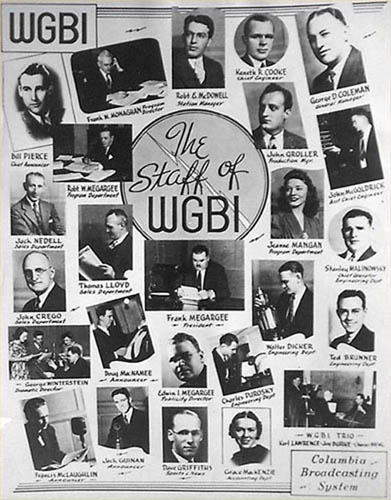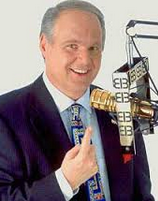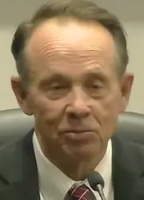➦In 1925...WGBI-AM (now WBZU) Scranton, PA signed on the frequency of 1250 kHz owned by Edward Megargee.In 1927, the station moved to 1300 kHz which it time shared with Scranton's other radio station, WQAN (now WEJL at 630 AM). The two stations which were time sharing a single frequency, moved to 880 kHz in 1931, and then again to 910 kHz by 1941 (the later move, forced by a nationwide frequency reassignment which took place in 1941). WGBI remained at 910 kHz (at 1,000 watts) when WQAN moved on to its own broadcast tower and new frequency of 630 kHz in 1948. This meant that WGBI had full-time use of the 910 kHz frequency where it remains to this day, as WBZU. WGBI was a CBS Radio network affiliated station by the 1940s.
The Megargee family's company, Scranton Broadcasters, spawned an FM station (now WGGY) and northeast Pennsylvania's second television station (now WYOU). The Megargees held on to the radio stations well into the 1990s. By the turn of the century, WGBI had been sold to Entercom and become a repeater of WILK-AM, existing mainly to improve its signal in Scranton. While WILK's daytime signal easily covers most of Scranton, the northern portion of the city only gets a grade B signal. At night, WILK-AM must power down to 1,000 watts, leaving most of Scranton with only a grade B signal.
WBZU in 2007 moved its transmitter to the tower location atop the Times Building at 149 Penn Avenue in downtown Scranton also being used by WEJL's transmitter. The full-time switch over to the new transmitter facility and tower location happened on August 2, 2007. This tower sharing arrangement repeats an arrangement the stations shared over 60 years ago in their early history. The efficiency of the new transmitter tower location also caused WBZU to slightly reduce its power to 900 watts to keep within FCC rules on signal strength and coverage.
➦In 1926...“Sam ‘n’ Henry” debuted on Chicago’s WGN radio. When they moved crosstown to WMAQ two years later the show was renamed “Amos ‘n’ Andy” and the voices of its creators, Freeman Gosden and Charles Correll played to huge depression-era audiences via NBC radio.
Although the players were white, the characters were portrayed as black. The popular radio show would attract over forty million fans at its peak during the depression. In 1943 the daily show became a weekly half-hour with an audience and supporting black actors; and in 1954 Gosden and Correll turned into Monday-through-Friday disc jockeys on the “Amos ‘n’ Andy Music Hall” with skits between records until their final sign off in 1960.
➦In 1932...columnist & future TV host Ed Sullivan joined CBS radio in a program of gossip and interviews.
➦In 1951...Rush Hudson Limbaugh IIII was born in Cape Girardeau, Missouri (Died February 17, 2021 from lung cancer). Limbugh was the most popular and most-listened-to conservative radio host in the United States.
Limbaugh began his career in radio as a teenager in 1967 in his hometown of Cape Girardeau, using the name Rusty Sharpe. Limbaugh graduated from Cape Girardeau, Missouri Central High School in 1969. He played football. Because of his parents' desire to see him attend college, he enrolled in Southeast Missouri State University but left the school after two semesters and one summer. According to his mother, "he flunked everything", and "he just didn't seem interested in anything except radio."After dropping out of college, Limbaugh moved to McKeesport, PA. In 1972, he became a Top 40 music disc jockey on WIXZ, a small AM radio station that reached much of the Pittsburgh area. He started with an afternoon show and later did mornings, broadcasting under the name Jeff Christie. Limbaugh moved to Pittsburgh station KQV in 1973 as the evening disc jockey, succeeding Jim Quinn. He was fired in late-1974, when the station was sold to Taft Broadcasting.
Jeff Christie Aircheck: Click Here (courtesy of Jeff Roteman's radio tribute website)
Limbaugh was reportedly told by management that he would never make it as on air talent, and should consider going into sales.
For the rest of the '70s, Limbaugh took jobs at several radio stations, working in music radio, before settling in Kansas City. In 1979, he left radio and accepted a position as director of promotions with the Kansas City Royals baseball team. There he developed a close friendship with then-Royals star third baseman and future Hall of Famer George Brett; the two remain close friends.In 1984, Limbaugh returned to radio as a talk show host at KFBK-AM in Sacramento, CA, where he replaced Morton Downey, Jr. The repeal of the Fairness Doctrine—which had required that stations provide free air time for responses to any controversial opinions that were broadcast—by the FCC in 1987 meant stations could broadcast editorial commentary without having to present opposing views.
On August 1, 1988, after achieving success in Sacramento and drawing the attention of former ABC Radio President Edward McLaughlin, Limbaugh moved to New York City and began his national radio show.
 |
| Stern's Class Photo |
His first on-air job in radio was WRNW in Briarcliff Manor, NY, where covered shifts in late December 1976. Stern was hired full-time, working a four-hour midday shift for six days a week on a $96 weekly salary. He subsequently became the station's production and program director for an increased salary of $250.
In 1979, Stern spotted an advertisement in Radio&Records for a "wild, fun morning guy" at rock station WCCC in Hartford, Connecticut. He submitted a more outrageous audition tape featuring Robert Klein and Cheech and Chong records with flatulence routines and one-liners.Stern was hired.























.png)























.png)
